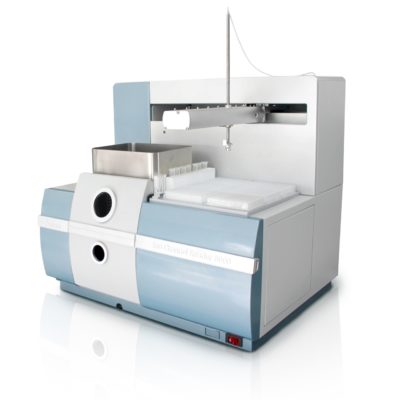
PRODUCT INFORMATION
ICR 8100- Primary Drug Screening Technology
Aurora’s ICR 8100 offers a mid-throughput, benchtop solution for ion channel screening, combining the sensitivity of atomic absorption spectroscopy (AAS) with patented microsampling and liquid handling technologies. It fills the functional gap where automated patch-clamp methods fall short—especially for electroneutral transporters.
Capable of assessing a broad range of voltage-gated channels (e.g., hERG, BK/SK, Kv1.1, KCNQ) and ligand-gated channels (e.g., KATP, nAChR), as well as ion pumps and transporters like Na⁺/K⁺-ATPase, the ICR 8100 accelerates drug development targeting critical membrane proteins.
A key application includes the Cation-Chloride Cotransporter (CCC)—a regulator of neuronal excitability and cell volume—whose activity is undetectable via voltage-based techniques. The ICR 8100 enables high-throughput measurement of absolute cytosolic and extracellular ion concentrations, offering a robust, voltage-independent method for ion channel and transporter analysis.

Ion Channel Reader 8100
- Programmable and automated solution for up to 5000 wells/day
- Automatic dilution, calibration and cleaning
- Adaptable to existing robotic automation
- Sample dilution not required
- High sensitivity
- On-line dilution
- Eliminates quenching effects associated with fluorescence
- Removes need to work with hazardous radioisotopes
- Avoids work restrictions posed by Rb’s short half-life
- Ideal for hERG channel assays
- Can assess both electrogenic and electroneutral transporters
- Medium Throughput: Up to 5000 wells/day
- Single Channel: Measures 1 sample at a time
- Minimum sample volume: 50 µl
- Accommodation: 96/384-well microplates
- Footprint: H.67 cm X W.55 cm X D.37 cm
- Fuel Source: Acetylene / Compressed Air
- Options: Plate Stacker / Barcode Reader
- Sensitivity: 0.05 ppm detection limit
- Precision: < 5% CV
For more validations on Aurora’s Ion Channel Reader, please click
Driggers, C.M.; Kuo, YY.; Zhu, P.; ElSheikh, A.; Shyng, SL. Nature Communication 2024, 15, 2502. https://doi.org/10.1038/s41467-024-46751-5
Li, Y.; Shang, Y.-S.; Li, X.; Zhang, Y.; Xie, J.; Chen, L.; Gao, F.; Zhou, X. European Journal of Medicinal Chemistry 2022, 243, 114776. https://doi.org/10.1016/j.ejmech.2022.114776.
Montalbano, A.; Sala, C.; Altadonna, G. C.; Becchetti, A.; Arcangeli, A. Heliyon 2023, 9 (10), e20112. https://doi.org/10.1016/j.heliyon.2023.e20112.
Terstappen, G. C. In Label‐Free Technologies for Drug Discovery; 2011; pp 111–124. https://doi.org/10.1002/9780470979129.ch8.
Chaudhary, K. W.; O’Neal, J. M.; Mo, Z.; Fermini, B.; Gallavan, R. H.; Bahinski, A. Assay and Drug Development Technologies 2006, 4 (1), 73–82. https://doi.org/10.1089/adt.2006.4.73.
Trivedi, S.; Dekermendjian, K.; Julien, R.; Huang, J.; Lund, P.-E.; Krupp, J.; Kronqvist, R.; Larsson, O.; Bostwick, R. Assay and Drug Development Technologies 2008, 6 (2), 167–179. https://doi.org/10.1089/adt.2007.090.
Fallah, H. P.; Ahuja, E.; Lin, H.; Qi, J.; Qian, H.; Gao, S.; An, H.; Zhang, J.; Xie, Y.; Dong, L. Frontiers in Pharmacology 2022, 13. https://doi.org/10.3389/fphar.2022.914499.
Qi, J.; Wang, Y.; Liu, Y.; Zhang, F.; Guan, B.; Zhang, H. Analytical and Bioanalytical Chemistry 2014, 406 (6), 1713–1721. https://doi.org/10.1007/s00216-013-7550-5.
Luo, L.; Guan, X.; Begum, G.; Ding, D.; Gayden, J.; Hasan, N.; Fiesler, V. M.; Dodelson, J.; Kohanbash, G.; Hu, B.; Amankulor, N.; Jia, W.; Castro, M. G.; Sun, B.; Sun, D. Molecular Cancer Therapeutics 2020, 19 (7), 1550–1561. https://doi.org/10.1158/1535-7163.mct-19-0910.
How does the non-radioactive flux assay compare to patch clamp?
The non-radioactive flux assay is considered a high throughput solution to investigate a broad range of membrane proteins including electro-neutral targets, to which conventional electrophysiology cannot be applied. The flux assay is capable of establishing the same drug potency rank orders as patch clamps.
What type of membrane protein targets can the ICR be applied to?
Membrane protein targets including voltage-gated and ligand-gated ion channels, co-transporters and pumps.
What is the general procedure of setting up flux assays?
Cells expressing the ion channels of interest go through a protocol of tracer loading, drug incubation, wash, treatment, and lysis before they are fed into the ICR. The ICR can fully automate the sample analysis procedure.
What are the main differences between the ICR 8100 and ICR 12000?
The minimal sample loading volume is for 50 ul for the ICR 8100 and 20 ul for the ICR 12000. The ICR 12000 has a throughput of processing 60000 wells/day as compared to 5000 wells/day on the ICR 8100. The ICR 12000 also has an optional plate stacker.
What plate formats are compatible with the ICR?
Standard 96 and 384 well plates.
Who are some of the organizations using the ICR?
Our customers include Amgen, Merck, AstraZeneca, Roche, Pfizer, University of British Columbia, Heibei Medical University, and more.











